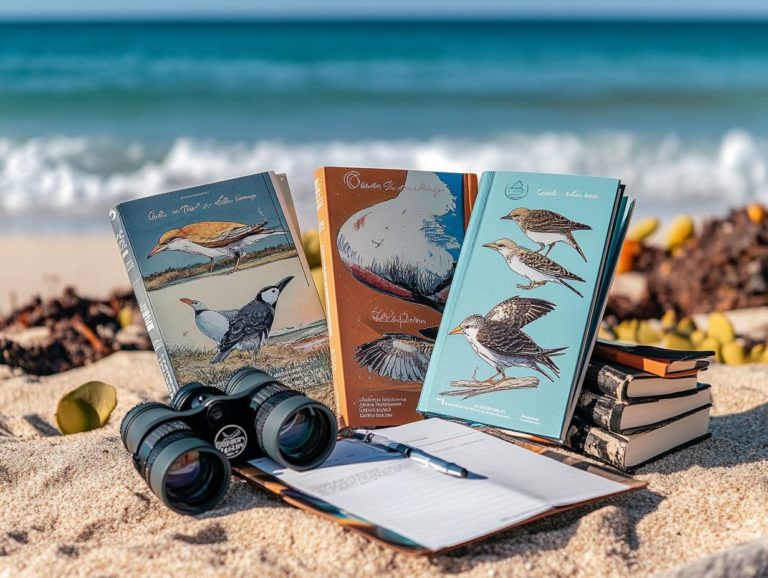Choosing the Right Field Guide for Your Region
Field guides, including comprehensive and portable guides, are indispensable companions for nature enthusiasts. They offer invaluable insights into the flora and fauna of diverse regions.
Whether you consider yourself a seasoned naturalist or an eager beginner, choosing the right field guide can significantly elevate your outdoor experience.
This article delves into the various types of field guides and identification guides available, highlights key features to consider, and presents helpful resources to broaden your collection.
By the end, you ll be fully prepared to select a guide that aligns seamlessly with your adventures in the wild.
Contents
- Key Takeaways:
- Choosing the Right Field Guide
- Types of Field Guides
- Features to Look for in a Field Guide
- Additional Resources for Field Guides
- Frequently Asked Questions
- What factors should I consider when choosing a field guide for my region?
- Do I need a separate field guide for plants and animals?
- Are there online field guides available?
- Can I use a field guide from another region?
- Should I prioritize a field guide with photographs or illustrations?
- Is it worth investing in a more expensive field guide?
Key Takeaways:

- Explore your region: Choose guides that focus on the area you’re visiting!
- Find what fits: Decide if you need a regional, species-specific, or general guide.
- Look for clarity: Choose guides with clear layouts, vivid illustrations, and reliable info.
What is a Field Guide?
A field guide is a critical resource for nature enthusiasts. It offers a wealth of information on various organisms, especially birds, and their habitats.
These guides serve as educational companions that enrich your explorations of the natural world. They cover essential aspects like visual characteristics, species identification, and ecological insights.
Field guides deepen your understanding of biodiversity and cultivate a more profound connection with the environment. Organizations like the Audubon Society play a crucial role in promoting these invaluable resources, ensuring they remain accessible to both aspiring ornithologists and seasoned naturalists.
Whether you’re wandering through the forests of the Northeast or the Mid-Atlantic regions, regional bird field guides you need to own are essential for grasping the intricacies of local species, their behaviors, and life cycles.
With detailed illustrations, photographs, and range maps at your fingertips, these guides enhance your experience while encouraging a commitment to wildlife conservation.
They also inspire you to take an active role in preserving natural habitats, making them crucial tools for education and environmental stewardship.
Choosing the Right Field Guide
Selecting the appropriate field guide is essential for your success in bird identification and understanding local wildlife. Consider creating your own birding field guide, as the right guide enhances your experience and influences the ease of use and the quality of information at your fingertips.
Factors to Consider
When selecting a field guide, consider several key factors to ensure effective bird identification. Look for visual features, species descriptions, and overall user-friendliness, and explore the most useful field guides for travel birding to enhance your experience.
A well-organized layout that allows for seamless navigation through various sections can significantly enhance your experience, whether you re a novice or a seasoned professional.
High-quality visual aids, such as detailed illustrations or photographs, are crucial. These images help you recognize the distinctive traits of different species.
Comprehensive species coverage from common birds to rare varieties enables you to broaden your understanding and appreciation of bird life. By prioritizing these aspects, you can maximize your field guide’s potential during your birdwatching expeditions.
Types of Field Guides
Field guides, including illustrated guides and local guides, are a treasure trove of knowledge. You can categorize them into several types:
- Regional guides are designed for specific areas, allowing you to delve into the unique wildlife of a locale.
- Species-specific guides focus on particular birds, offering detailed insights for enthusiasts.
- General guides cover a broader spectrum of wildlife, providing you with a versatile toolkit for identification.
Each type serves its purpose, enhancing your experience in the great outdoors.
Regional Guides

Regional guides are invaluable for bird watchers and nature enthusiasts like you, offering tailored ecological information and identification strategies for specific areas, such as the Northeast and Mid-Atlantic regions. To enhance your experience, learn how to use a field guide for bird watching.
These resources spotlight unique local habitats and help you understand the interaction between avian life and its environment. By focusing on familiar species and their behaviors, these guides make learning fun!
Local ecosystems often harbor distinct birdlife. With exploring bird habitats with field guides in hand, you gain insights into the birds you might encounter, enriching your outings and deepening your connection with nature.
Species-Specific Guides
Species-specific guides delve into particular birds, highlighting their common species, unique markings, and identifying features throughout various juvenile stages.
These resources provide insights into the visual characteristics and behaviors that set each bird apart, making it easier for you whether you’re an enthusiastic hobbyist or a dedicated researcher to identify birds accurately. By focusing on distinct markings and subtle variations in plumage or size, these guides empower you to hone your observational skills.
Understanding the different life cycles presented in these resources deepens your appreciation for avian patterns and ecosystems, allowing you to navigate your surroundings with greater confidence and play a more impactful role in conservation efforts.
General Guides
General guides offer a thorough overview of various bird species. They’re perfect if you’re a beginner looking to gain a solid understanding of avian wildlife and resources for nature study.
These guides cover many species and boast user-friendly layouts that enhance accessibility for enthusiasts of all levels. Using straightforward language and clear illustrations, these comprehensive guides make complex information digestible for both novices and seasoned bird watchers.
Packed with valuable tips on identification techniques and behaviors, they encourage you to engage in immersive learning experiences in the field. This educational value cultivates a deeper appreciation for nature, enabling you to connect with your surroundings more mindfully and effectively.
Features to Look for in a Field Guide
When selecting a field guide, it’s crucial to consider specific features that enhance usability. Look for effective organization and a layout that makes navigation easy, as highlighted in Field Guides: Your Companion in the Outdoors.
High-quality illustrations and photographs bring the content to life. Informative descriptions are a must, providing you with the insights to deepen your understanding and appreciation of the subject.
Organization and Layout
A well-organized field guide with a clear layout is essential for quick referencing and effective identification. This enhances your experience whether you’re a beginner or a seasoned bird watcher.
Such guides should feature intuitive identification keys and visually captivating illustrations that make locating species straightforward and enjoyable. The growing popularity of user-friendly apps complements traditional guides, enabling you to swiftly search and filter information based on specific characteristics.
This blend of physical guides and digital tools elevates your overall experience, allowing you to navigate through a wealth of information effortlessly. Ultimately, an organized layout instills confidence in your identification skills and fosters a deeper connection with birdwatching, making it an accessible pursuit for everyone.
Illustrations and Photographs

High-quality illustrations and photographs are critical elements of any field guide. They serve as visual aids that assist you in identifying birds through their distinctive field marks and characteristics.
These visuals streamline the identification process and provide valuable insights into bird behavior and their ecological contexts. By showcasing various species in different poses, habitats, and interactions, these illustrations enable you to gain a deeper appreciation of avian life and the intricacies of their environments.
This context is vital for both birdwatchers and conservationists. It allows you to recognize how specific traits, such as plumage and feeding habits, are finely tuned to their ecological niches.
Ultimately, effective visual aids enhance your field experience, fostering greater appreciation and awareness of avian diversity and the challenges these remarkable creatures face.
Discovering Birds: Information and Insights
A well-crafted field guide delivers detailed information and thorough descriptions of species. This assists you in effective bird identification and enhances your understanding of the small details of how species interact with their environment.
This comprehensive approach sharpens your ability to differentiate between various species and deepens your appreciation for the intricate relationships within ecosystems. Incorporating essential features such as habitat preferences, behavioral traits, and conservation status helps you engage more fully with your surroundings.
Accurate identification gives you the power as a wildlife enthusiast to actively contribute to conservation efforts. You can make informed decisions that support vital protection initiatives.
Ultimately, these guides serve as invaluable resources, bridging the gap between curiosity and responsibility, while fostering a greater respect for biodiversity and the essential roles these species play in maintaining ecological balance.
Additional Resources for Field Guides
Besides traditional field guides, you have a wealth of resources at your fingertips. Explore online platforms and visit local bookstores. Both offer valuable tools to enhance your bird identification skills and provide educational resources for your nature study.
Online Sources
Online sources and portable apps grant you convenient access to bird identification resources. They enhance your engagement with wildlife conservation and enrich your nature exploration experience.
Platforms like eBird and Merlin Bird ID, including the Merlin Bird ID App, present user-friendly interfaces. These tools enable both novice and seasoned birdwatchers to quickly identify specific species using either photos or audio recordings.
These amazing tools will deepen your appreciation for avian biodiversity and gather valuable data for conservation organizations, supporting vital research and habitat protection.
Apps like BirdNET harness the power of artificial intelligence to help you recognize bird calls, making birdwatching accessible to everyone, no matter their experience level. These user-friendly apps and advancements elevate your personal enjoyment and contribute to the broader mission of wildlife preservation.
Local Bookstores and Libraries
Local bookstores and libraries offer a remarkable selection of informative books, including illustrated guides. These serve as invaluable educational resources for both seasoned bird watchers and those just entering the world of nature study.
These establishments not only provide a diverse array of field guides, including local guides, but also nurture a sense of community among nature enthusiasts. By hosting readings, workshops, and local nature outings, they create opportunities for you to connect, share experiences, and learn from others.
This collaborative atmosphere fosters a deeper appreciation for local wildlife and habitats, including bird habitats. Engaging with knowledgeable staff and fellow patrons can lead to the discovery of new interests and techniques, ultimately enriching your understanding of nature and its intricacies.
Frequently Asked Questions

What factors should I consider when choosing a field guide for my region?
When choosing a field guide, consider the common species native to your area. For more detailed advice, check out this guide on how to choose the right bird field guide. Think about the environments you will explore and the specific features you want to learn about.
Do I need a separate field guide for plants and animals?
You might want a separate guide based on your interest. Some guides cover both plants and animals, while others focus on one category.
Are there online field guides available?
Yes, many online guides are available. Keep in mind that physical field guides are often more comprehensive and useful in areas without internet access.
Can I use a field guide from another region?
While some species may overlap, it’s best to use a guide specific to your region. For instance, the best bird field guides for coastal regions can provide excellent resources, along with guides from the Audubon Society or Peterson Field Guides.
Should I prioritize a field guide with photographs or illustrations?
This choice is personal. Photographs are generally more accurate, while illustrations can offer more detail and clarity on visual features.
Is it worth investing in a more expensive field guide?
Your level of interest will guide this decision. A pricier guide might have more detail and better images. However, a less expensive one can still serve you well for casual exploration.
Explore your options now! A more costly guide could unlock a treasure trove of knowledge.






